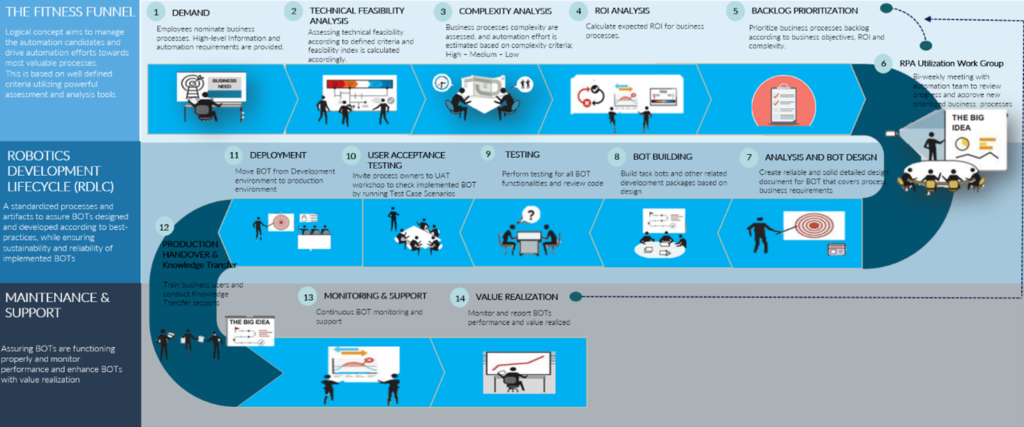
By: Basil Ikhlaif, Director of Technology & Consulting Services
We, as people, were gifted an opportunity to watch the world as it progressively evolved into an intelligent one. In turn, all industries initiated a journey of adapting to the ever-changing technological advancements of this age while business leaders were put on the lookout for innovative ways to support their business goals and objectives. One such innovation that has gained significant attention and transformed the way businesses operate is Intelligent Automation, which combines the power of Artificial Intelligence (AI) and Robotic Process Automation (RPA) to create a new breed of a digital workforce that offers the capabilities of performing complex tasks with speed, accuracy, and efficiency.
Now more than ever, companies are going to create new possibilities for innovation and strategic decision-making. Most businesses that identified their improvement points as reducing overhead costs, swiftly streamlining operations, and gaining a competitive edge, often look to incorporate Intelligent Automation into their operations to unlock success. Over the years, Intelligent Automation continued to play a significant role in supporting companies to reach their strategic objectives and that was done by deploying digital workers to considerably augment the work and secure a smooth workflow.
According to reports, 81% of companies are working to achieve their financial saving goals by investing in RPA. Organizations are turning to RPA as a solution for financial savings for five key reasons: this technology reduces costs, increases productivity, offers scalability, diminishes human error, and provides speed and efficiency. RPA automates repetitive and consuming tasks on which employees used to spend 10%-25% of their time on them. Thus, RPA frees up employees’ time and allows them to redirect their efforts toward more strategic and higher-value tasks and activities that.
In this blog, we will explore the empowering journey of Robotic Process Automation (RPA), the significance of transforming the workplace into an intelligent establishment, the power of the digital workforce for businesses, and the integrated development framework that TSME developed to ensure the successful implementation of RPA projects.
The Empowering Journey of RPA
Numerous studies indicate that within the next 10-15 years, approximately 47% of jobs are expected to be replaced by an automated or digital workforce. In this context, Robotic Process Automation (RPA) stands out as a critical form of digitization. Its implementation is undeniably essential for companies looking to enhance their added value in the future. Embracing RPA can lead to significant improvements in efficiency, productivity, and overall performance, enabling businesses to adapt and thrive in an increasingly automated world.
Broadly speaking, Robotics Process Automation (RPA) is a software technology used for automating business processes by replicating human actions within software applications, just as a human user would. RPA is particularly effective for handling monotonous, well-defined, and time-consuming tasks. It operates by extracting data from various digital sources like emails and applications, then processing this data based on predefined business rules, and finally transferring the transformed outputs to other computer systems.
The rise of the digital workforce was followed by the continuous evolution and remarkable achievements of Robotic Process Automation (RPA) throughout the years. The expansion of this technology is a testament to an empowering journey of transformations from the early stages of RPA development to its current advanced state of being a suitable innovation for automation, efficiency, and growing businesses.
Even though RPA was focused in its early stages on merely automating repetitive, rule-based tasks, it has evolved to handle more complex tasks and to incorporate Artificial Intelligence and machine learning capabilities. Therefore, organizations were given access to more powerful benefits that are deemed necessary today such as reducing manual errors, enhancing process efficiency, and boosting the level of accuracy.
Intelligent Automation, since it first emerged, has directly supported all industries in their transformation experiences to become based on intelligence and to immediately reap the benefits of RPA. For instance, this technology has enabled organizations in the financial industry to automate activities like invoice processing, financial reporting, and compliance checks to massively reduce the risk of human error and save valuable time and resources. As a result, reports show that around 40% of financial services providers around the globe will have implemented RPA technology by 2025.
RPA managed to give sectors worldwide the advantage of fulfilling their strategic objective and making important achievements. The continuous progress of Intelligent Automation and RPA has successfully enabled organizations to drive innovation and access numerous benefits from reducing costs and improving efficiency to optimizing and streamlining operations.
The journey of RPA has proved to be an empowering one for businesses across all industries, and as the journey continues, the digital workforce is expected to have an even more positive response as it evolves into a more intelligent tool that can work on increasingly complex tasks. As technology proceeds to evolve, RPA will further empower organizations to reach new levels of thriving success, a huge return on investment (ROI), and a matchless competitive advantage.
From Mundane to Extraordinary: Workplace Transformation
The deployment of software bots as virtual employees at an establishment led to an incredible transformation, taking mundane and repetitive tasks, and elevating them to new levels of efficiency, productivity, accuracy, and reliability. The introduction of Robotic Process Automation (RPA) enables the workplace landscape to experience an incredible shift that makes it evidently clear that transforming into an intelligent establishment is essential for a smooth workflow.
Companies have been struggling with repetitive tasks that take hundreds of valuable hours to complete. Additionally, employees were left with limited capacity to engage in higher-value tasks as they focus on time-consuming and repetitive activities. These activities were also found to leave a chance for risk of human error, lack of efficiency, and diminished employee morale, consequences which could become a hindrance and create challenges to a business.
The integration of digital workers into the workplace was the most suitable innovative solution for a transformed, successful business. Introducing Artificial Intelligence drastically increased employee morale and gave them an opportunity to manage more important and strategic tasks that bring true value. Designed to mimic human actions and seamlessly integrate with existing systems and applications, software bots perform tasks around the clock without interruption, with high speed, accuracy, and reliability.
Not only did the digital workforce boost job satisfaction and engagement, but also empowered organizations in their overall operations. With the integration of Intelligent Automation, organizations were able to achieve enhanced customer experience with the capability of swiftly and accurately responding to customers.
The process of transforming the workplace from mundane to extraordinary is simple. It involves a set of steps to reach the best outcome and achieve a comprehensive and smooth experience. The main goal of the process includes identifying tasks that can be automated and outlining workflows, all with the necessary collaboration among related parties. Additionally, the journey highlights change management and awareness sessions for a proper handover and knowledge transfer to facilitate an easy and flawless transition. Once the journey is at its finish line, organizations can see the benefits of this intelligent transformation and will be able to stay competitive in a world that is witnessing continuous technological advancement that affects the business landscape and allows it to thrive.
Automating Success: The Power of The Digital Workforce
The deployment of software bots as a digital workforce was a game-changer for businesses across industries. By 2025, RPA is expected to achieve an adoption rate of 95% on a global scale, based on reports published by Gitnux. This is caused by the multitude of benefits and features presented by intelligent automation technology which heavily contributes to the flourishing state of businesses.
- Streamline & Automate Repetitive Tasks: as bots work 24/7 without interruption, efficiency and productivity record a major increase within an organization.
- Scalability: organizations are empowered with scalability and flexibility to meet workloads and demands while ensuring efficiency in operations and optimizing costs.
- Cost-Saving Potential: companies receive an opportunity to reduce labor costs associated with manual work along with achieving a significant return on investment (ROI).
- Minimizing Error Risks: enhanced accuracy and compliance are achieved as the organization adopts a fully reliable solution that works consistently and accurately.
- Blooming Operational Performance: leveraging digital workers facilitates major improvements in operational performance as employees are allowed to focus on more strategic tasks.
The digital workforce powered by RPA offers numerous benefits, from speed, accuracy, and reliability, to guarantee enhanced customer experience, strategic decision-making, and an overall flourished business. The power of Intelligent Automation is substantial, it drives better operational performance and allows companies to unlock new capabilities and reach new heights in their success.
TSME Message to Clients – Growing Together
At Technology Strategies Middle East (TSME), our focus extends beyond merely completing and delivering projects; it revolves around cultivating long-lasting relationships with our valued customers. We firmly believe in providing not just a service but also expert guidance throughout the entire journey of digital transformation. That’s why our approach to RPA implementation projects begins with a comprehensive process of discovery and assessment, allowing us to offer an evaluation of the feasibility of automating business processes through RPA technology. Our goal is to provide valuable insights and recommendations on the best approach to automation, ensuring it aligns seamlessly with our client’s unique needs and adds significant value to their operations. We view RPA as a crucial piece of the larger digital transformation puzzle and we take great care in ensuring that this technology seamlessly fits into our clients’ transformation journey, driving them towards greater success and efficiency. Building strong partnerships and fostering mutual growth is at the core of what we do, and we are committed to guiding our clients every step of the way toward a successful and rewarding digital future.
TSME RPA Integrated Development Framework:
Over the past years, TSME has developed RPA integrated development framework, drawing from valuable experience gained through previous RPA projects’ implementations. This framework is designed to offer a structured and comprehensive approach encompassing the entire RPA implementation life cycle, right from demand management to the seamless operation of the digital workforce. It has become a proven reference for ensuring successful RPA project implementations that can automate simple to complex business processes using RPA technology.
The reference manual associated with this framework serves as a detailed guide, presenting the methodology and guidelines to navigate through the entire RPA project implementation life cycle. Notably, during the creation of this methodology, special emphasis was placed on ensuring its applicability across various RPA implementation domains, including Banking, Finance, Support Services, and more. As a result, the methodology provides a robust and adaptable framework to achieve successful outcomes for RPA projects.

The RPA Delivery Framework consists of three primary pillars, forming the basis for a well-structured and effective RPA implementation process.
- Pillar #1 – Fitness Funnel
–Stage #1 – Discover & Assess
Inception of the delivery framework begins with the identification of potential automation candidates. Through this initial phase, the team conducts a high-level requirements elicitation, along with comprehensive technical feasibility, and complexity assessments, and the expected ROI is calculated for the potential business processes. The primary goal is to optimize resource utilization and maximize the expected ROI for the business processes. As a result of this stage, a backlog (Fitness Funnel) is generated, encompassing viable and prioritized use cases for implementation.
At TSME, when we embark on any RPA journey with our clients, we establish a CoE (Center of Excellence). This CoE is a specialized team or group within a client’s organization, dedicated to overseeing, managing, and promoting the adoption of RPA across the enterprise. One of the primary responsibilities of this committee is to identify and prioritize the most suitable processes for automation.
We firmly believe that implementing an RPA Center of Excellence can significantly enhance the success and scalability of RPA initiatives within an organization. By fostering a structured approach, it ensures the maximization of automation benefits while mitigating potential risks associated with RPA adoption. With a CoE in place, our clients can streamline their automation efforts, achieve efficiency gains, and drive transformative changes across their operations.
2. Pillar #2 – Robotics Development Lifecycle (RDLC)
– Stage # 2 – Analysis and Design
During this stage, a thorough definition of detailed requirements is undertaken for the selected use cases, involving comprehensive documentation of both business and system requirements. The primary deliverables at this phase include a Process Definition Document (PDD) and a BOT Design Document (BDD).
– Stage #3 – Develop and Test
This stage revolves around the transformation of the defined use cases into functional Bots, adhering to the designed specifications which are documented in the BOT Design Document (BDD). The RPA team, along with the business teams, thoroughly tests the Bots to ensure that it is implemented as per the requirements. Additionally, the code undergoes rigorous review by other members of the RPA team. The principal outcome of this stage is the development and testing of Task Bots, ready for deployment.
– Stage #4 – Deployment
Upon successful completion of the testing phase, the Bots are transitioned to the live environment (Production) to commence their operational deployment. In this stage, the main deliverables include the release notes and the actual deployment of the Bot in the production environment. This allows the Bots to actively perform their designated tasks and contribute to the operational processes.
3. Pillar # 3 – Maintenance and Support
– Stage # 5 – Maintenance
The monitoring process involves keeping a close eye on their performance and efficiency. Any identified bugs or issues are promptly addressed through bug fixing and ongoing improvements are implemented based on the insights gained from monitoring and user feedback. This iterative approach ensures that the Bots maintain optimal functionality and continue to deliver the intended benefits to the business.
In Summary
This is the era of emerging technologies, innovation, and intelligence. A digital world that is evolving at a fast-paced rate and expected to elevate businesses and open the door to opportunities we are yet to perceive. Intelligent Automation, to be specific, is rapidly rising in the world of business with RPA becoming one of the most sought-after solutions. RPA is currently giving access to a fully reliable workforce that empowers businesses across industries in a way that was unimaginable just a few years ago. Being capable of automating tasks, gaining a huge return on investment (ROI), and securing a competitive edge are only of the key advantages that make this innovation necessary. RPA software bots are estimated to become even more powerful soon, projected to play an increasingly crucial role in shaping the future of the workplace.
About the Author
Basil Ikhlaif, a visionary leader and the Director of Technology & Consulting Services at Technology Strategies Middle East (TSME). With a passion for harnessing cutting-edge technologies to fuel the digital transformation journey, Mr. Ikhlaif leads a team of technical, business, and project managers experts, striving to pave the way for the next generation of services.
With over two decades of experience, Mr. Ikhlaif has achieved numerous accomplishments and delivered successful results. His expertise lies in providing state-of-the-art business solutions and world-class consultancy services. Proficient in program/project planning and management, automation using top-notch technologies, IT service management, business consulting in technology, process optimization, risk management, and team building.
Mr. Ikhlaif’s forward-thinking approach and unwavering commitment to delivering value make him an indispensable asset in navigating the ever-evolving landscape of digital transformation. His dedication to leveraging technology to its fullest potential not only benefits TSME’s clients but also inspires the industry at large.



